Although it’s often called a mountain, Mount Lycabettus is a hill. With an elevation of 277 meters above sea and a prominence of 227 meters above the city, Lycabettus Hill becomes the second-highest point within the Athenian basin (the highest one being Tourkovounia further north). The hill’s almost perfectly conical, emblematic southwestern part dominates the skyline of central Athens.
Its summit is by far the city’s most cherished viewpoint. Crowds of tourists and locals gather at it daily, particularly for sunset, to marvel at the stunning view of the Acropolis and the city left far below the hill cliff. Besides the view, on the hill you can enjoy a hike on its forested slopes, a meal at one of its restaurants, or even a play or concert at its open-air theater. When I am in Athens side-gigging as an independent tour guide, I often bring my guests there to their great delight. If you have more than a day or two in Athens, Mount Lycabettus is definitely worth visiting. And in this post, you’ll find all the information you may need to carry out your visit.
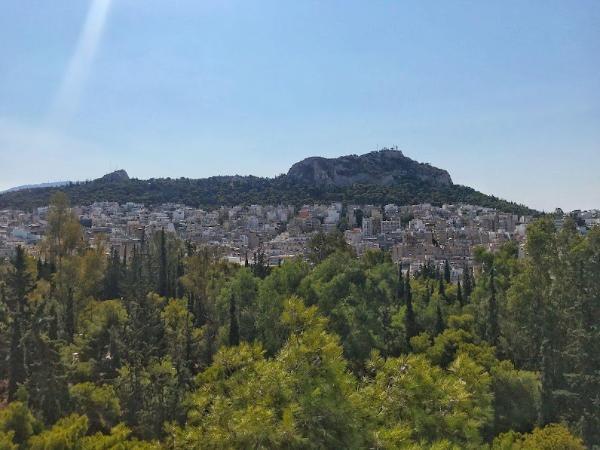
Contents
Quick Facts
- Height: 277 meters
- Prominence: 227 meters
- Opening hours: 24 hours
- Entry fee: free
- Closest metro station: Evangelismos
- Walking time from the station to the top: 22 minutes
- Walking time from the station to the cable car: 10 minutes
- Cable car cost: €10 both ways, €7 one way
- Cable car working hours: 9:00–2:30
- Best time to visit: sunrise (sunset too if you don’t mind crowds)
- Official website: lycabettushill.com
How to get to get there
The top of Mount Lycabettus is accessible by one road, a cable car line, and numerous walking paths all around its periphery. Here you will find detailed directions for how to reach it by all methods. Check out the map at the bottom of the page to see more routes.
By foot
The view of the soaring Lycabettus might seem a bit daunting from below, but the climb isn’t as bad as it looks. The zigzagging trails smooth out the steepness significantly and can lead you up before you know it. From the hill foot, the climb takes roughly 15 minutes for a person of average fitness and down to 10 minutes or less for a stronger hiker. Respectively, the complete walk from the nearest metro station of Evangelismos, should take about 22 minutes down to 15. The metro stations of Syntagma and Megaro Mousikis are only slightly farther away, and the metro stations of Omonoia, Victoria, and Ampelokipi are all within reasonable walking distance. The new metro line currently under construction, scheduled to go live in 2029, will comprise four additional stations very close to the hill.
From Evangelismos, follow Marasli Street, heading north from outside the station, until the final crossroad and turn left on Distria Doras Street. At the dead end of the road begins the trail. View the route on Google Maps.
From Syntagma Square, go left on Vasilisis Amalias Street (the avenue in front of the parliament) and take the second right on Kriezotou Street. Turn right at the end of the road, immediately left on Pindarou Street, and follow it all the way to the trailhead, located shortly after Pindarou Street curves to the right and becomes Xanthippou Street. View the route on Google Maps.
If you want to save the walk from the metro station, you may as well catch the bus 060 from either Syntagma (bus stop) or Evangelismos (bus stop) and get off at any of the 12 stops around the hill’s circumference. The 4th and the 5th stops are the closest to the top. Here is the complete bus route and the timetable.
Google Maps shows only a limited number of the hiking trails on Lycabettus. But as soon as you hit any one of them, the rest is straightforward. As long as you walk up, all routes lead to the top. If you come from Evangelismos or Syntagma, stick to the stepped path. There will also be plenty of people around to ask or follow.
If you can afford it physically, climbing on foot is the most rewarding way up the Lycabettus.
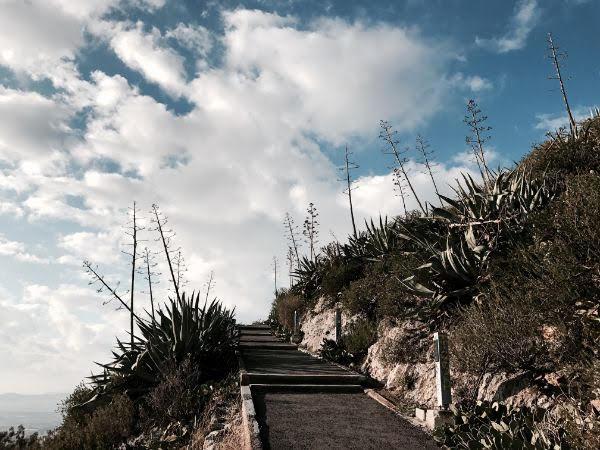
By cable car
The funicular station of Lycabettus is located by the hill’s southern foot (location). You can get there from Evangelismos Metro Station in a 10-minute walk or by bus 060. The ride, going entirely through a tunnel, is 210 meters long and lasts about 3 minutes. The cable car runs every 30 minutes (down to 10 during peak hours) from 7:00 am to 2:30 am 365 days a year. It is operated by the Sky Bar restaurant beside the hilltop and gives a lift to an average of 300,000 passengers annually. The per-person ticket fare is €7 for one way and €10 for both ways. Here is the official, up-to-date information.
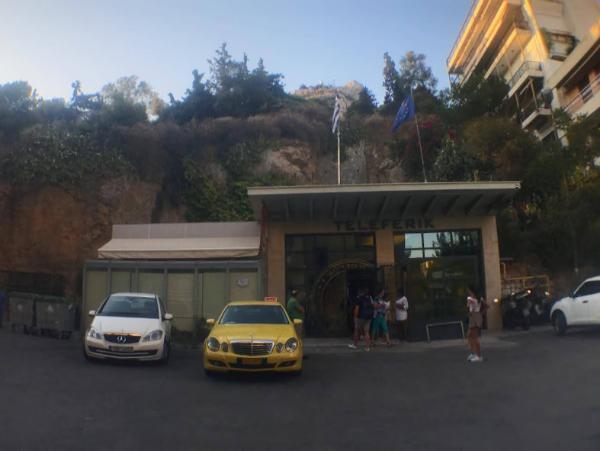
By car
The aptly named Lycabettus Road traverses the hill between the 7th bus stop in the west and the Daskalogianni-Paligenesias crossroad in the east. There is a large parking lot outside the theater, from where it takes a 5-minute smooth walk to the peak.
A smaller road branches off at the western foot and leads to the beginning of the main stepped path to the peak. Parking space is limited there and it can be very congested in the evening.
By taxi
A cab from Syntagma, Monastiraki, or anywhere in central Athens shouldn’t charge more than €5. You’ll have to walk for a couple of minutes from where it drops you off to the peak.
What to do there
The foremost reason to visit Mount Lycabettus is the view. From the little terrace laid on its narrow top, you will wonder at an astounding, omnidirectional panorama that covers the entire, vast metropolitan area of Athens, the five mountains that encompass it on three sides (Parnitha, Hymettus, Penteli, Aigaleo, and Poikilo), and the Saronic Gulf with its scattered islands extending to the southern horizon.
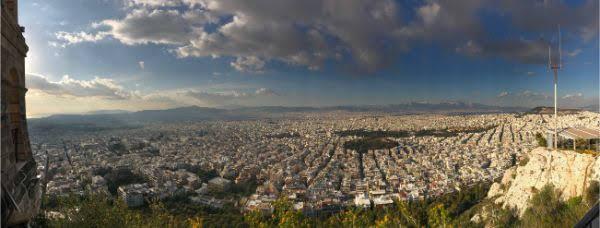
It’s best to come for sunrise or sunset; not only for the golden hour, but also to avoid climbing in the extreme day heat if it’s summer. If you’re an early waker, prefer the sunrise. At sunset, the place can be clogged with people to the point of having to jostle your way to the railings and get a glimpse of the view before getting jostled away yourself. I’d recommend you visit some other, less crowded hill for sunset, such as the nearby Strefi or Philopappou. Lycabettus Hill is also great at night, when it’s frequented by dispersed companies of young cannabis smokers and romantically detached couples surveying the twinkling city.
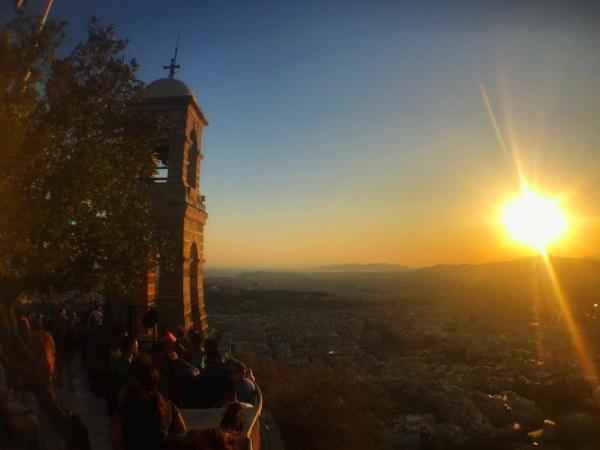
Lycabettus is also ideal for short hiking getaways. Its forested slopes feature scores of trails that you could spend a whole day exploring. Besides lovely views and pleasant nature, you can check out its picturesque churches. The island-style white Church of Saint George of Lycabettus with its characteristic steeple stands on the hilltop. Tucked on the cliffside below, there is an additional complex of quaint chapels.
If you happen to visit on some special day (like one of Greece’s two national days on March 25th and October 28th, the official visit of some high-profile foreign politician, or the funeral of some high-ranking civil or military functionary), you may witness cannon salute shots being fired from the shooting range on the western slope of Lycabettus.
By the by, you can make the most of your jaunt to Lycabettus by discovering the neighborhoods at its base. Below the hill’s southern slope, lies Kolonaki: Athens’ luxurious quarter par excellence. In sharp contrast, over to the hill’s opposite side spreads Exarcheia: the city’s renowned counter-cultural district. Each for its own reasons, these are two of the most exploration-worthy neighborhoods of the Greek capital.
Opening Hours & Entrance Fee
Mount Lycabettus is a municipal park, free to visit 24/7. You only have to bear the cost of the cable car if you don’t want to walk to the top. The ticket price is €7 one way.
Church of Saint George of Lycabettus and other churches
Saint George is a picturesque, whitewashed church on Lycabettus’s top. The church in its current form was constructed in the late 18th century over the remnants of an earlier church which—as is typical for Greek hilltop churches—was dedicated to Prophet Helias (Elijah). That in turn was built over a succession of places of worship going back to an ancient altar of Zeus. In the late 19th century, courtesy of the then Queen of Greece Olga, an arcaded stone steeple was added. Today, the Church of Sainte George of Lycabettus is particularly popular for wedding and christening ceremonies among pious, well-heeled Greeks who can afford the markup of the privileged manager-priests.
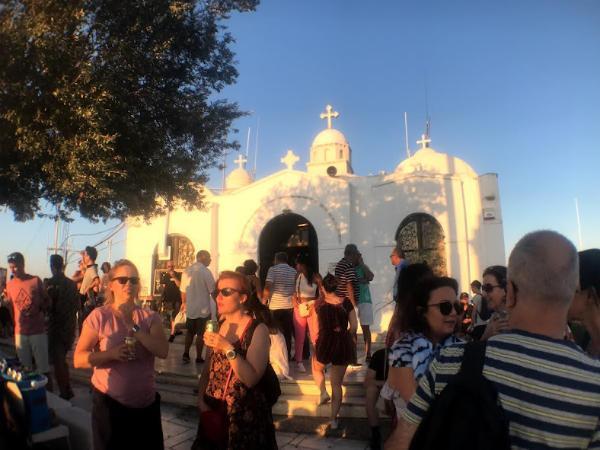
Within a cave on the cliffy slope below the hilltop, lies another elegant old church, dedicated to two different saints called Isidore. The church was erected in the 12th century in the cave that was a frequent lair of proto-Christian hermits. It was reconstructed in 1931 after a negligent sacristan set it ablaze a year earlier. A beautiful garden and three additional chapels (Saint Mary of Egypt, Saints Anna and Paraskevi, and Saint Ioudas Thaddaios) are found around the church.
Theater of Lycabettus
On the site of an abandoned quarry near the hilltop, stands the open-air Amphitheater of Lycabettus. It first opened as a venue for propaganda-screening events by the 4th of August Regime in the late 1930s. The theater in its current form, with a capacity of 3,000 seats, was constructed and inaugurated in 1965. It remained closed for restoration between 2008 and 2023. A side drive-in cinema operated in its parking lot during Covid. It has held many eminent shows and concerts over the years, and world-class artists ranging from Ray Charles and Chuck Berry to Black Sabbath and Radiohead have performed in it. You can check out the schedule here (GR).
Cafe/Restaurants
Two upscale, fine-dining restaurant-bars are situated on the top of Lycabettus Hill: Orizontes Lycabettus and Sky Bar. Their selling point is the view, which is obviously great, but in terms of food and service, they’re rather mediocre, overpriced tourist traps. Personally, as a local, I would never eat there. But if you anyway want to try out the experience (or just show off what a big spender you are on Instagram), out of the two I’d recommend Orizontes Lycabettus. Here are their website and their menu.
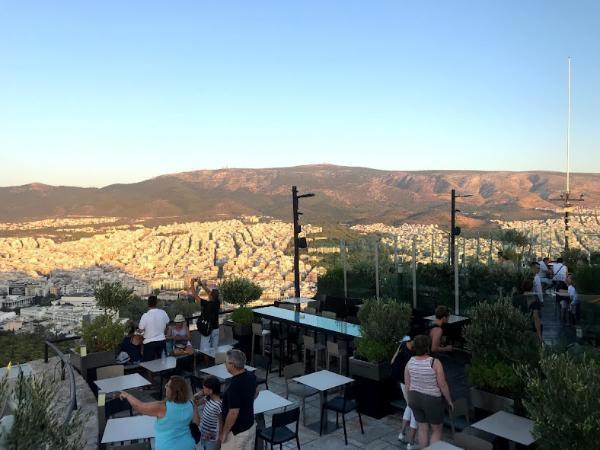
A more economical and overall better option for dinner or brunch on Mount Lycabettus is the Prasini Tenta restaurant a bit further down the slope. You’ll get a tastier meal, friendlier service, and a no less spectacular view. These are their website and menu.
If you’d rather spare your cash but still want to grab some grub during your visit to the hill, go to the Lycabettus Canteen by the theater’s parking. Veondors with drinks in coolboxes also usually hang around.
Tours
Here are a few Athens tours including a visit to Mount Lycabettus.
Browse more Athens tours on GetYourGuide or Viator.
Hotels
Situated below the summit of central Athens, real estate proprietors on the foot of Lycabettus haven’t forgone the chance to turn their properties into fortune-making machines. Particularly in Kolonaki district, by the hill’s southern slope, you can find some of the most luxurious, vista-endowed hotels and apartments in the city. Explore accommodation options near Mount Lycabettus on the map below.
Lycabettus Run
Since 2015, Lycabettus Run has been organizing trail footraces on Mount Lycabettus. The event is held annually sometime in late winter. You may want to check it out, even participate if you have the stamina, in case your visit coincides. Find out more on the organizer’s site.
Name
The provenance of Lycabettus’s name is unclear. There are a few etymological theories. The predominant one says it stems from the noun lycavas (λυκάβας) meaning year, owing to an annual religious festival that used to take place on the hill. Another prominent theory says it derives from lycauges (λυκαυγές, twilight) and vainein (βαίνειν, to come). And another common hypothesis relates it to lycos (λύκος, wolf). Many lexicologists believe the word’s origin is pre-Hellenic.
The name’s standard pronunciation is /ˌlaɪkəˈbɛtəs/ in English and /likaviˈtos/ in Greek.
History
In Greek mythology, Mount Lycabettus was created accidentally. Athena, the matron goddess of Athens, was hauling a boulder from nearby Pallene to bolster the defences of the Acropolis. Then a crow confronted her midway with the grim tidings of ophidian king-to-become Erichthonius’s birth. In her consternation, she dropped the rock, and it became Lycabettus. Quite unfairly, she cursed all crows to be black ever since.
In antiquity, the Athenians used Lycabettus for worshipping, defence, quarrying, and since constructing a cistern on its slope in the 2nd century AD, water supply.
When Athens became the capital of the modern Greek state in 1834, Lycabettus was barren and used only by goats for grazing. At about that time, systematic quarrying began on its slopes, providing for the needs of the growing city. Perhaps not coincidentally, the architect Stamatios Kleanthis, who co-planned the new capital’s development, became the owner of the first quarry. After a longer-than-a-century series of vicissitudes and clashes between speculators and conservationists, quarrying the hill was definitively prohibited in 1960.
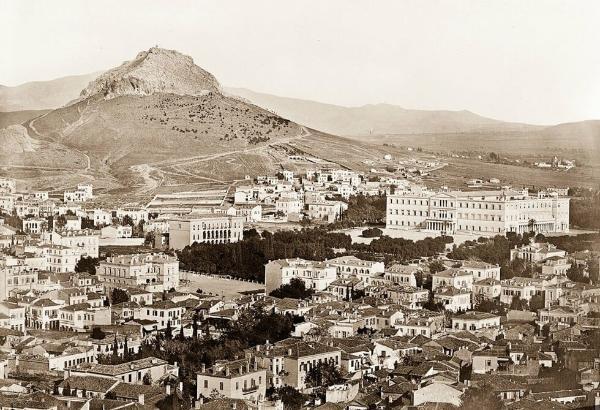
Following earlier failed attempts, methodical afforestation of Lycabettus was carried out between 1880 and 1915. During the same period, a plan was proposed to turn the hill into a recreation zone. That would include cafes, kiosks, playgrounds, fountains, artificial waterfalls, a hotel, and a colossal monument to the Greek Revolution on the hilltop. The plan never came to fruition because the state was broke.
In 1925, the government approved another plan to build a casino on Lycabettus. It was fortunately dropped due to the vehement reaction of the press and the people. In 1929, a beacon was installed on the hilltop in honor of the International Peace Conference that Athens hosted that year. It was named the Peace Beacon and stood until the unpeaceful Nazis blew it up in 1941.
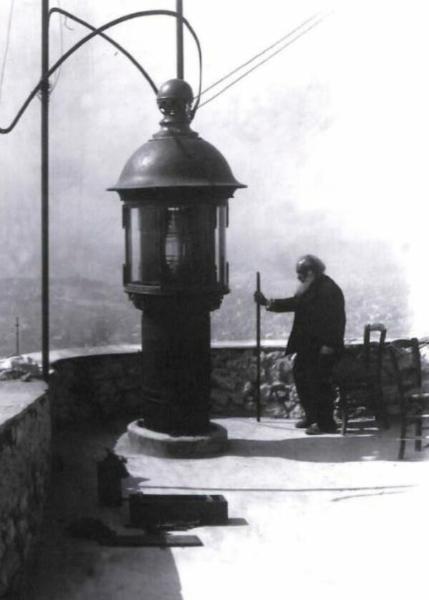
In recent decades, Lycabettus Hill was preserved as a public park and promoted as a popular tourist destination.
Video
Photo Gallery
View (and if you want use) all my photographs from Mount Lycabettus.
